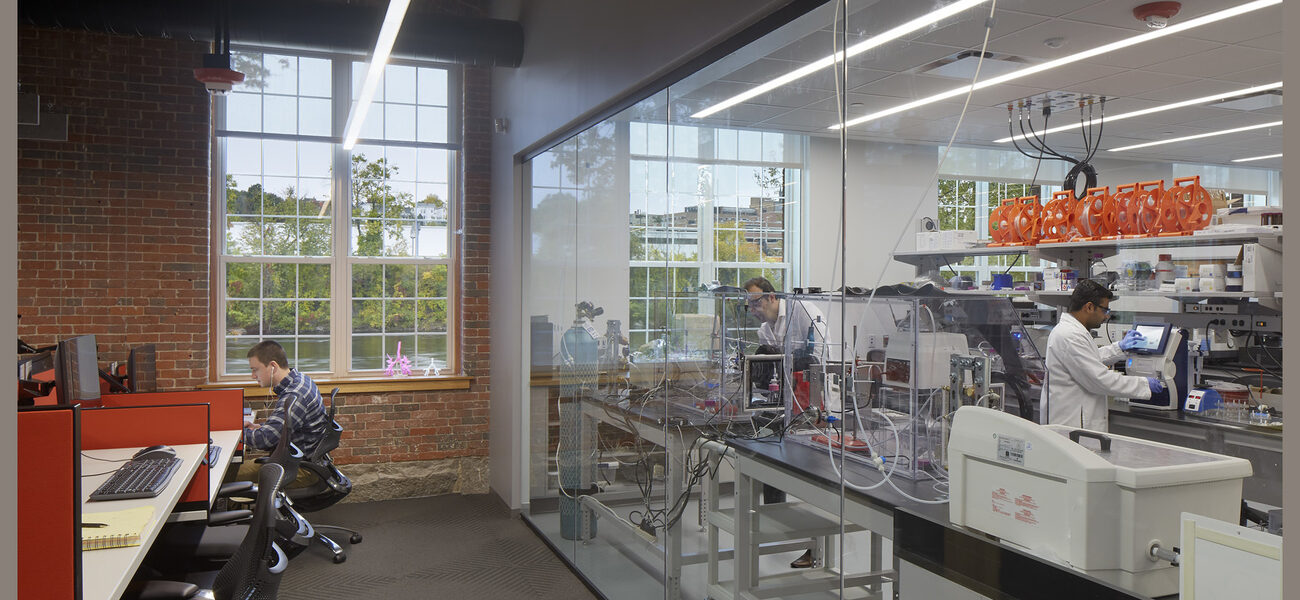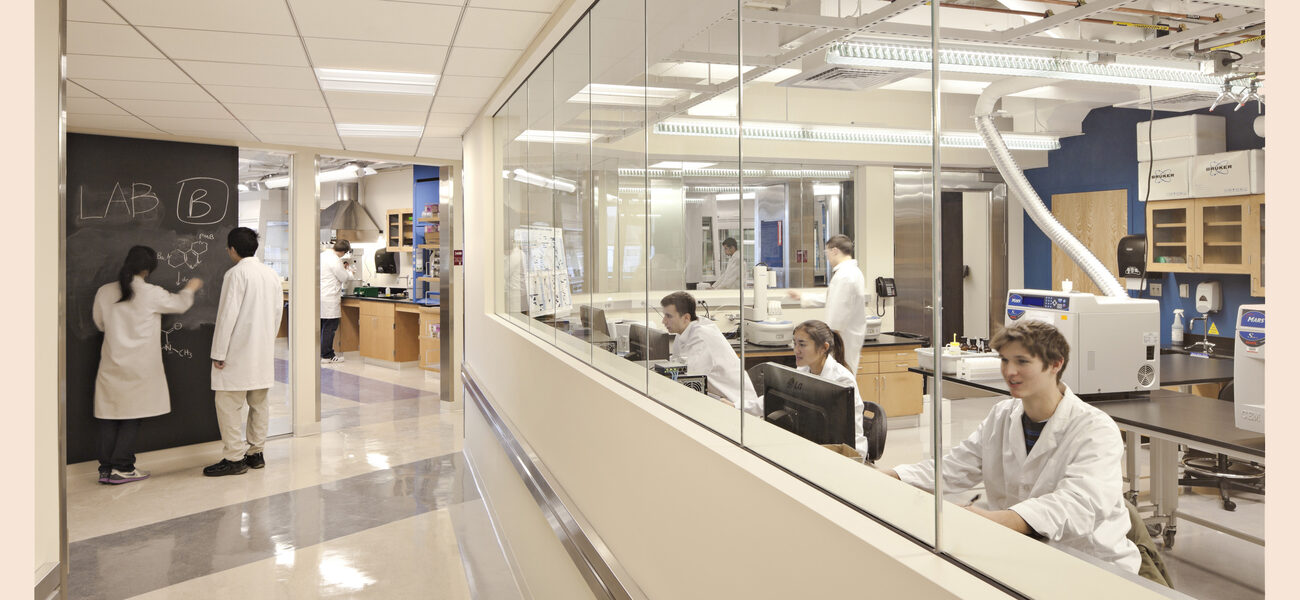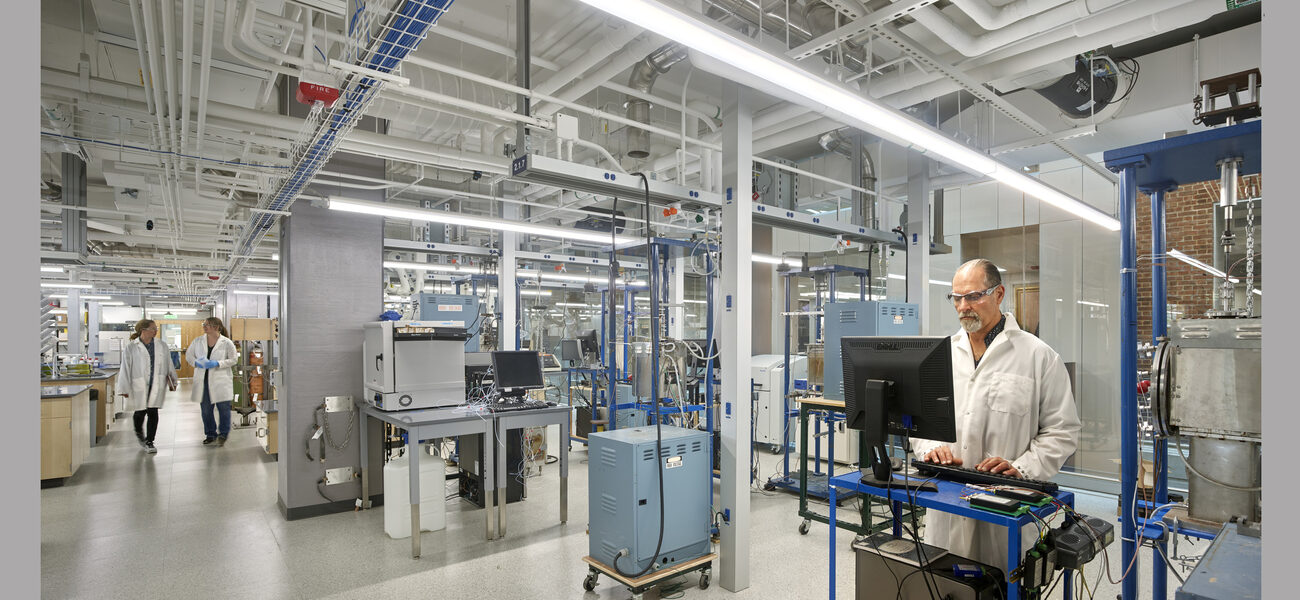The COVID-19 pandemic has amplified the need for the research community to respond quickly to changing markets and to understand the value of laboratory spaces that are flexible, adaptable, and scalable. We’ve seen stadiums converted to makeshift hospitals, “drive-through” testing sites pop up in vacant parking lots, and testing laboratories continually ramp up production to expedite results. This quick-thinking behavior has been inspiring to witness but daunting to execute. Laboratories, by nature, are among the most complex building typologies, where the utmost importance is protecting both the health and safety of their occupants and the integrity of the research. The complexities of the resulting design can be challenging to undertake, but when faced with the extreme circumstances of a pandemic, it is possible to expedite the process with a combination of strategies.
It Takes a Village
Commit to the team effort and agree to make the project a priority. When attempting to modify your space quickly, it is critical that all key players and decision-makers be on board. Start by clearly defining your goals in order to help identify who those key players will be. They may include end users; procurement leads; environmental health and safety, life safety, or biosafety representatives; industrial hygienists; lab technicians; building owners; property managers; general contracting team members; and the full planning, architecture, and engineering team, with special emphasis on the mechanical engineer. Having all parties participate in critical discussions allows for decisions to be made in real time and will help expedite the process tremendously. Having those key decision-makers on the team is essential when questions arise regarding issues such as laboratory protocols, air change rates, chemical quantity allowances, and storage. With everyone at the table from the outset, critical decisions can be made quickly, saving both time and money.
Keep the Foot on the Gas
Set an achievable, consistent schedule to keep everyone accountable. Fast-paced projects require a regimented schedule and habit creation, even if it means meeting at the same time every day. Scheduling can be a challenge with a large team representing all parties. Establishing a regular meeting time allows individuals to make the project a priority and plan their other commitments around it. Consider this cyclical, four-step process:
- Begin the design cycle with a full team meeting, emphasizing that everyone’s participation is essential. Elect a moderator who can ensure everyone’s input is heard and track their comments. This is especially important when conducting meetings remotely via platforms such as Zoom and WebEx.
- Immediately following the full team meeting, establish a set amount of time to allow the design team to incorporate feedback and coordinate changes.
- With design updates complete, re-group with pricing and procurement leads to review impacts on both the budget and subsequent construction schedule.
- Complete the cycle by sending all relevant, updated information and action items to the full team for review at the next full team meeting, and prepare to repeat the process.
A full cycle can be completed in a single day, which means early mornings and late nights, but the process can be adjusted to accommodate an institution’s particular scheduling needs. It is important to set realistic goals to establish a sustainable rhythm, and so individuals feel that goals can be accomplished in the time allocated.
Think with the Idea of “Sufficiency” in Mind
Like most businesses, the for-profit, private research industry has an underlying driver when making decisions—to efficiently and effectively execute a mission while maximizing profit. The team must draw upon this mindset when creating or modifying a laboratory environment while simultaneously maintaining the budget and the schedule. Encourage the team to produce a viable solution in the least amount of space. When assessing the viability of a reduced footprint, discuss the need for future growth and determine if portions of the buildout can be deferred. The idea of saving space can be beneficial only if it does not create issues in the future, so it is important to balance the immediate need with the long-term solution.
Laboratories contain three types of useable spaces: equipment space, workspace, and material space. Equipment space is often non-negotiable, requiring operational and safety clearances above and beyond the instrument footprint itself. So, think critically about the types and quantities of equipment being purchased and focus on those items that offer some degree of control. Are 6-foot fume hoods mandatory, or can the researchers adequately operate out of a 4-foot hood? Bench space is becoming less frequently built to suit, and remote technologies are further reducing the need for physical bench space. To that end, researchers in both academic and professional settings recognize the value of utilizing flexible casework. This flexibility allows a short-term solution for purchasing only what is needed, but its mobility provides an opportunity to easily adapt over time. When specifying benches, consider the dimensions. Are 6-foot-by-36-inch benches needed or will 5 feet by 30 inches suffice? This may seem like an insignificant decision, but consider this 5.5-sf reduction applied to the total number of benches throughout the space—it can save a significant amount of floorspace.
Material space is arguably one of the prime areas to find space efficiencies. Beyond the nuts and bolts of a laboratory, study the amount of physical space materials occupy. Non-essential storage within a lab can consume valuable real estate, not just in the physical footprint it inhabits (and its associated construction), but also in the amount of energy it takes to condition the environment containing it. It is worth considering whether precious laboratory real estate can be saved or reduced simply by modifying internal operational procedures. For example, consider the frequency of sample deliveries or hazardous waste pickup to reduce the footprint of storage needs. Additionally, processes that can be managed remotely further reduce the need for physical space. If research can continue unaffected by modifying operational procedures, the need for physical space can reduce and positively impact an expedited construction process. If there is one thing that COVID-19 has taught us, it’s the power of remote technology and the potential for this to become our “new normal.”
Location and Infrastructure
Interior buildouts typically can be accomplished faster than ground-up new construction projects, but speed is not the only consideration. When reviewing the feasibility of building out a lab within an existing space, think critically about what systems are available compared to what is needed. Consider the following common laboratory infrastructure needs:
- Mechanical Systems: One of the most important safety aspects of a lab is its air flow design. The number of air changes per hour, the ability (or inability) to recirculate air, pressurization, air cleanliness; and/or the need for laboratory exhaust all heavily impact the mechanical design. Think about how much capacity is available in the system and determine where the increase is required. In addition, if new mechanical chases or pathways are needed, it may impact the available footprint, so it’s best to begin talking through these things with the mechanical engineer and those representing environmental health and safety, biosafety, and industrial hygiene very early on to understand what parameters are acceptable.
- Electrical Systems: When expediting a laboratory buildout, laboratory equipment specifications may evolve over time, especially if instruments are being purchased new. In the absence of having all cutsheets available, think strategically about how power will be run to and within the lab space. Developing an agreed-upon, standardized, modular method for distributing power will allow the contractor to proceed with construction while giving the end user flexibility in equipment selection. When it comes to emergency power, unless a sufficient capacity of backup power is available, be strategic about where this is required. If possible, investigate options for localized UPS systems which can serve as battery backup for those items that truly require uninterrupted power.
- Plumbing Systems: House systems for plumbing—a centralized vacuum or compressed air system, specialty water or gas types, or even specialty drainage systems—are very common in laboratory settings. If the space you are considering does not have house-supplied plumbing that fits your needs, consider localized solutions to save both time and money. For example, both vacuum and compressed air can be provided as a localized unit. Stand-alone deionization (DI) polishing systems can be added to an existing laboratory water supply, and where acid neutralization is needed, localized units can be added upstream of a drain as an accessory to a sink. These types of localized options allow you to be strategic about where infrastructure is truly needed, while also allowing for the ability to modify and adapt over time as laboratory requirements evolve. Another common plumbing provision is floor drains at emergency showers. Talk to your safety representative about whether these are truly needed and explore the operational impact if they are omitted; if plausible, this, too, can result in potential savings.
- Technology Systems: Technology is continually evolving. Laboratory instrumentation is advancing more and more toward remote technology capabilities. Construction time associated with the installation of cabling can be reduced if the team is in a position to review new equipment options, and if working via a wireless connection is a feasible alternative to hard-wired ethernet connections. If building automation or control systems are required for laboratory processes, bring the contractor on early and have them participate in the design process. Encourage coordination between the general contractor and the systems installer, which will speed the return to full operation.
Think About the Supply Chain
When it comes to procurement, whether it be contractor-furnished material or owner-provided equipment, remember that the COVID-19 pandemic has affected nearly every part of the construction industry, including material delays due to factory shut-downs, interrupted customs processing, and mandatory quarantines for traveling personnel. In a more traditional project delivery method, there may be time to obtain competitive pricing from multiple bidders. However, in an expedited scenario, time is of the essence, and it’s important to remain flexible. For example, if your space needs a series of fume hoods, traditionally, these have about an 8- to 12-week lead time, which may or may not work within your new timeframe. In this scenario, it may be worth it to speak directly with a distributor who carries a variety of different fume hood manufacturers and can help find a solution based on availability. So, when you begin to think about procurement and the supply chain, seek resources that are readily available on the market, today, with minimal lead times, and place orders as soon as possible.
Similarly, it is critical that you work with a contractor you know and trust who is well-versed in the materials, means, and methods of your space. In a volatile market, the construction team is key to understanding up-to-the-minute pricing metrics and must have the ability to reach directly out to the subcontractors who will be performing the work. When delivering a project in an expedited manner, it is important to understand that speed often results in increased costs, so a trusted contractor will be able to discern premium pricing from what is reasonable for the scope of work. Eliminate gaps in information by treating them as the invaluable team member that they are and ensure their participation as an integral part of the design process.
COVID-19 has changed the world as we know it, and we as a society have been forced to evolve. We understand the power of remote technology and staying connected like never before. Many people are rediscovering how to do more with less, pushing farther and faster to innovate and discover solutions. In the design and construction industry, the limits of our dexterity have been tested, and we have repeatedly demonstrated the aptitude to rapidly respond. Though we may continue to face challenges, we will continue to persevere.
By Laura Vargas, AIA, NCARB, LEED AP BD+C
Vargas is project director and associate principal at EYP Architecture & Engineering.



